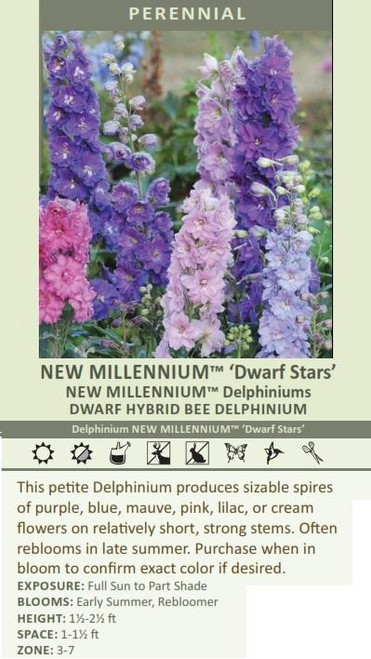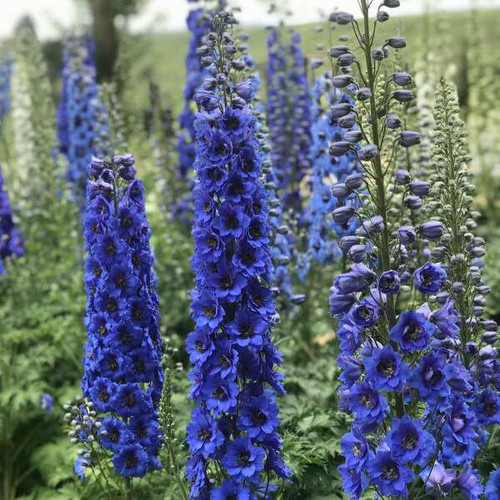Product Description
Delphinium New Zealand 'Mini Stars' (30)ct Flat
New Zealand Delphiniums
Common Name: Dwarf Hybrid Bee Delphinium
If you love the look of traditionally tall Delphiniums but they’re just too tall for your use, you’re in luck! From the breeder of the New Zealand Hybrids comes a series of truly compact Delphiniums that have all the beautiful characteristics of their taller cousins except their height.
Topping out under 2½' tall, these new compact Delphiniums never need staking and won’t fall over in their pots. They can be grown near the front to middle of the border and work better in windy sites than taller varieties.
This new series will be sold in single color strains in future years. In its first year of introduction, we are offering this mixed color strain of ‘Mini Stars’ which includes a variety of purple, blue, mauve, pink, lilac, and cream-colored flowers. Some have contrasting central bees and others are solid in color. All share a bushy, well-branched habit and strong flower stems.
Delphiniums are a classic garden perennial. These plants are excellent for adding height to small spaces. Their tall flower spikes are easily recognizable when they come into flower in summer. When in flower, the spikes of these plants become heavy and should be staked to avoid toppling over in rough weather, especially taller varieties. Newer hybrids are longer lived than some of the more traditional cultivars.
Delphiniums thrive in the cooler climates of the north country, though they will grow as far south as zone 7. The New Millenium hybrids, however, tend to be more tolerant of heat and humidity. They grow best in rich, well-drained soil with a basic pH. If your soil is naturally acidic, adding lime will help to provide these conditions. They are also heavy feeders. The addition of compost or manure to the soil as well the use of granular fertilizer will result in healthier, stronger plants.
Delphiniums can be grown in full sun or partial shade, though full sun may help to prevent powdery mildew. When planting, be sure to set the crown at or above soil level to avoid rot. Since their stems are hollow, taller varieties of Delphiniums should be staked to prevent damage from wind and rain. These new hybrids tend to be longer lived than their short-lived cousins but may be propagated from basal cuttings.
Height: 1.5-2.5 Feet
Spread: 12.0-18.0 Inches
Hardiness Zones: 3,4,5,6,7
Flower Color: Multicolored
Full Sun (> 6 hrs. Direct Sun) - Part Shade (4-6 hrs. Direct Sun)
Average Water Needs
Average to Fertile Soil Quality
Bloomtime: Early Summer to Early Fall
Attracts Butterflies and Hummingbirds
Bee Friendly
Deer and Rabbit Resistant
Seasonal Interest: Dried Seed Heads
Growth Rate: Medium
Border Plant, Cut Flower, Cut Foliage, Dried Flower, Mass Planting, Specimen, Focal Point
Delphinium New Zealand 'Mini Stars', also known as Candle Larkspur or Dwarf Hybrid Bee Delphinium , is a compact delphinium cultivar that offers a vibrant array of multicolored flowers in a manageable size. Unlike its taller relatives, 'Mini Stars' typically reaches a height of 18-36 inches, making it an excellent choice for smaller gardens or container gardening. This variety blooms in early summer, displaying striking flowers in shades of blue, purple, and pink.
Appearance 'Mini Stars' boasts a bushy, well-branched habit with strong flower stems that support its vibrant blossoms. These new compact Delphiniums never need staking and will not fall over in their pots. The flowers are sizable and come in various colors, including purple, blue, mauve, pink, lilac, and cream. Some flowers have contrasting central bees, while others are solid in color. The foliage is green and palmate, providing a delicate frame for the colorful flower spikes.
Growing Conditions 'Mini Stars' thrives in full sun or partial shade and prefers fertile, medium moisture, well-drained soil with a basic pH. If your soil is naturally acidic, adding lime will help to provide these conditions. It is important to provide a sheltered location to protect the plant from strong winds. This variety is hardy in zones 3-9. While one source mentions hardiness zones 3-7 , another expands this range to 3-9, suggesting adaptability to a wider range of climates.
Care Requirements This cultivar is relatively low-maintenance. Deadheading spent flower spikes encourages a second bloom in late summer or early fall. In spring, apply a high-phosphorus granular fertilizer. A balanced fertilizer using calcium and potassium nitrate is preferred. Once flower initiation occurs, use less nitrogen and more potassium and phosphorus. Tired or mildew-infected foliage can be cut back in summer to rejuvenate the plant. In the fall, cut back plants to within 6 inches from the ground after they enter dormancy. This decreases the risks of overwintering pests and diseases.
Propagation These hybrids can be propagated from basal cuttings. This allows gardeners to expand their 'Mini Stars' collection or share cuttings with fellow enthusiasts.
Pests and Diseases While generally disease resistant, 'Mini Stars' may be susceptible to certain pests and diseases. These can include aphids, borers, leaf miners, mites, beetles, cutworms, sowbugs, slugs, nematodes, and thrips. Potential diseases include Impatiens necrotic spot virus, aster yellows, Verticillium wilt, bacterial blight, stem canker, damping-off, smut, crown rots, Botrytis blight, black leg, crown gall, leaf spots, powdery mildew, rusts, and chlorosis. Watch for powdery mildew, botrytis, and erwinia soft rot when high humidity and temperatures occur. Avoid stagnant air conditions, especially when flower buds are forming. A general fungicide treatment is advisable if these environmental conditions persist.
Landscaping Uses 'Mini Stars' is a versatile plant with various landscaping applications. Its compact size makes it ideal for smaller gardens where it can be placed in the middle or front of a border.
Here are some ways to incorporate 'Mini Stars' into your garden design:
- Borders: Plant 'Mini Stars' in groups or as a standalone specimen in borders.
- Containers: 'Mini Stars' thrives in containers, either alone or combined with other plants.
- Cottage Gardens: Its vibrant colors and compact size make it a perfect addition to cottage gardens.
- Flower Beds: Use 'Mini Stars' to add height and color to flower beds.
- Mass Plantings: Create a dramatic effect by planting 'Mini Stars' in mass.
Other Notable Features
| · Attracts | Hummingbirds and butterflies |
| · Resistant to | Deer and rabbits |
| · Excellent as | Cut flowers |
| · Staking | Generally, not required |
| · Bred for | Longevity and disease resistance |
| · Toxicity | All parts of the plant may cause severe discomfort if ingested, potentially leading to severe illness, paralysis, and even death. |
Delphinium New Zealand 'Mini Stars' is a delightful addition to any garden. Its compact size, vibrant colors, and low-maintenance nature make it an excellent choice for gardeners of all levels. This cultivar thrives in full sun or partial shade, prefers fertile, well-drained soil with a basic pH, and is hardy in zones 3-9. With proper care, which includes deadheading spent flower spikes and occasional fertilization, 'Mini Stars' can reward gardeners with a second bloom in late summer or early fall. Whether used in borders, containers, or as part of a cottage garden, 'Mini Stars' is sure to add beauty and charm to any outdoor space. Remember to keep this plant away from children and pets due to its toxicity.
Thirty (30) plants per flat (or tray). Approximate Plug Measurements: 3 inches deep x 2 inches wide.
Other Details
The most important part of the plant is its root system. Healthy roots are the foundation of a healthy, vibrant plant. The type of plug container used is based on the specific needs of the plants. Perennials offered as bare root traditionally perform better when planted as bare root.Planted in a specialized mix, potted plants have well established root systems. Top growth stage will vary depending on the current life cycle and time of year when shipped. In Winter and early Spring dormant plants may be shipped. Dormant plants may be planted right away, even before the last frost date.
Most bare root varieties are field grown for at least one season, though Hemerocallis and Hosta are grown for two seasons. The bulk of the soil is removed during the harvesting process and the tops of most varieties are trimmed back to the crown. They are graded, packed in shredded aspen or sphagnum moss and stored in freezers until ready to be shipped.
See our Container Sizes and Bare Root Perennials pages for more information.
Plant information and care is provided in the Overview section, Plant Genus Page and general information is provided in the Planting Care & Guides. Additional questions can be asked on each Plant page.
Plant Spacing: Using the maximum mature spread or width of a plant to guide spacing, ensures space to grow to full size. To fill an area sooner, plant them closer together. Just remember, future thinning or transplanting may be needed.
Water: Keep a close eye on newly planted perennials, especially throughout the first growing year. Most early plant loss is due to too much or too little water!
















